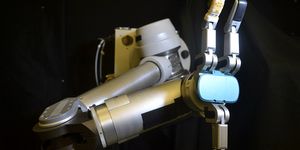Role of Parkinson's Disease Gene is Found
Mutations in the LRRK2 gene have been identified as the most common genetic cause of late-onset Parkinson’s disease. Researchers have shed light on the normal function of the gene, which has not been clear. It was found to be critical for the survival of neurons in the brain that contain dopamine, cells which are impacted by Parkinson’s. This new work, reported in Neuron, may help create better treatments for the disease.
"Since its discovery, researchers have been trying to define LRRK2 function and how mutations may lead to Parkinson's disease," said Beth-Anne Sieber, Ph.D., program director at the National Institute of Neurological Disorders and Stroke (NINDS). "The findings in this paper emphasize the importance of understanding the normal role of genes associated with neurodegenerative disorders."
In the brain, LRRK2 hangs out around LRRK1, a related protein. When only LRRK2 is mutated, Parkinson's disease symptoms can eventually result, and brain pathology can be identified in affected humans as they grow older. But in mouse models, a mutation or loss of LRRK2 did not cause the dopamine-producing neurons to die. The investigators suspected that is because LRRK1 acts to compensate or fill in for LRRK2 during the relatively brief lifespan of a mouse, which is only about two years.
"Parkinson's-linked mutations such as LRRK2 have subtle effects that do not produce symptoms until late in life. Understanding the normal function of these types of genes will help us figure out what has gone wrong to cause disease," explained Jie Shen, Ph.D. Shen is the Director of the NINDS Morris K. Udall Center of Excellence for Parkinson's Disease at Brigham and Women's Hospital and the senior author of this study.
Shen and her team created mice that lacked LRRK1 and LRRK2 to learn more about the normal roles of these genes. In the modified mice, dopamine-containing neurons were found to be lost from areas of the brain, in a manner consistent with Parkinson’s disease and starting when the mice were about 15 months old. After analyzing the affected brain cells, the scientists saw a hallmark of Parkinson’s disease; a protein called α-synuclein was accumulating, and pathways that dispose of cellular junk were dysfunctional. Other dopamine-containing neurons began to look like they were self-destructing, or becoming apoptotic.
"Our findings show that LRRK is critical for the survival of the populations of neurons affected by Parkinson's disease," noted Dr. Shen.
Because it has been assumed that LRRK mutations make the protein overactive, therapeutics have tended to focus on inhibition of LRRK2. But this may not be a great idea.
"The fact that the absence of LRRK leads to the death of dopamine-containing neurons suggests that the use of inhibitory drugs as a treatment for Parkinson's disease might not be the best approach," explained Dr. Shen.
Next, Shen and her team are deleting the LRRK1 and 2 genes from only neurons that contain dopamine. That will allow them to assess how that affects the brain, and they will get around the dire consequences and shortened lifespan seen when the genes are removed from the whole body of the mouse.
Learn more about Parkinson's disease and the LRRK2 gene from the video.
Sources: AAAS/Eurekalert! Via NINDS, Neuron









